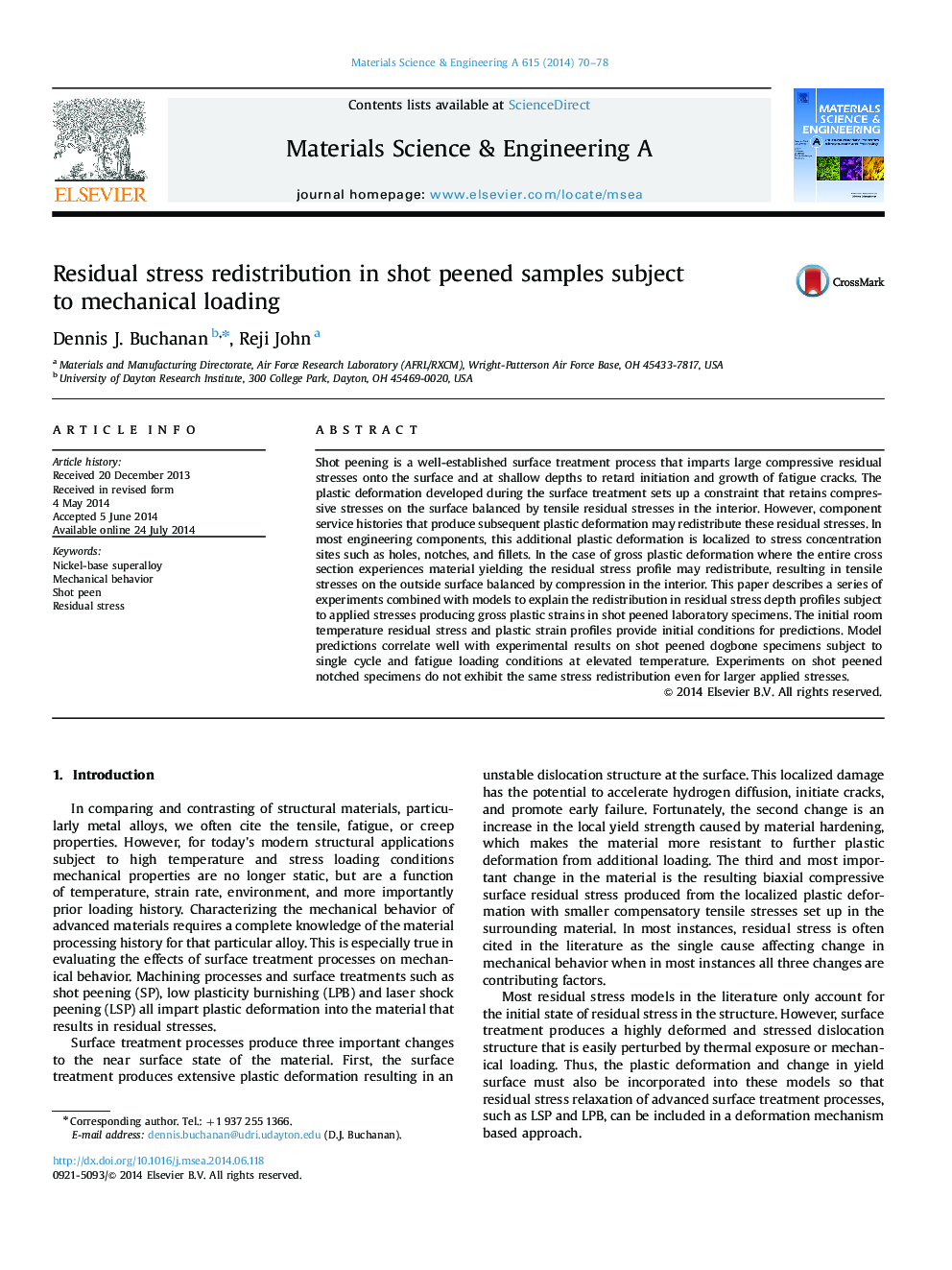| کد مقاله | کد نشریه | سال انتشار | مقاله انگلیسی | نسخه تمام متن |
|---|---|---|---|---|
| 7979926 | 1514728 | 2014 | 9 صفحه PDF | دانلود رایگان |
عنوان انگلیسی مقاله ISI
Residual stress redistribution in shot peened samples subject to mechanical loading
ترجمه فارسی عنوان
توزیع مجدد استرس باقی مانده در نمونه های شسته شده شات با توجه به بارگیری مکانیکی
دانلود مقاله + سفارش ترجمه
دانلود مقاله ISI انگلیسی
رایگان برای ایرانیان
کلمات کلیدی
نیکل پایه فوق العاده، رفتار مکانیکی، ضرب و شتم، استرس باقی مانده،
ترجمه چکیده
پینینگ شات یک فرایند تصفیه سطح به خوبی است که فشارهای باقی مانده فشاری را به سطح و در عمق کم عمق می بخشد تا مانع شروع و رشد ترک های خستگی شود. تغییر شکل پلاستیک در طی درمان سطحی ایجاد محدودیتی را ایجاد می کند که فشارهای فشرده روی سطح را متعادل می کند و تنش های کششی کششی در داخل را حفظ می کند. با این حال، تاریخچه خدمات کامپوننت که موجب تغییر شکل پلاستیک می شوند، ممکن است این تنش های باقی مانده را دوباره توزیع کند. در بیشتر اجزای مهندسی، این تغییر شکل پلاستیک اضافی به محل تمرکز استرس مثل حفره ها، مهره ها و فیله ها متمرکز شده است. در مورد تغییر شکل پلاستیکی ناخوشایند که در آن تمام قسمت های متخلخل مواد را تحمل می کنند، پروفیل استرس باقی مانده ممکن است توزیع شود، و در نتیجه تنش های کششی روی سطح بیرونی متعادل شده با فشرده سازی داخلی. این مقاله یک سری آزمایشات همراه با مدل های توضیح می دهد که توزیع مجدد در پروفیل عمق تنش باقی مانده در معرض تنش های کاربردی که موجب تولید سوسیس های پلاستیکی ناخواسته در نمونه های آزمایشگاهی شده است. استرسهای باقی مانده دمای اتاق و پروفیل های پلاستیکی پلاستیک، شرایط اولیه را برای پیش بینی فراهم می کنند. پیش بینی های مدل با نتایج آزمایش شده در نمونه هایی از سگ های گلوله ای که تحت شرایط یکسان و شرایط خستگی در دمای بالا قرار دارند، همبستگی خوبی دارد. آزمایشات بر روی شات نمونه نازک شده، همان توزیع مجدد تنش را حتی برای تنش های اعمال شده بیشتر نشان نمی دهد.
موضوعات مرتبط
مهندسی و علوم پایه
مهندسی مواد
دانش مواد (عمومی)
چکیده انگلیسی
Shot peening is a well-established surface treatment process that imparts large compressive residual stresses onto the surface and at shallow depths to retard initiation and growth of fatigue cracks. The plastic deformation developed during the surface treatment sets up a constraint that retains compressive stresses on the surface balanced by tensile residual stresses in the interior. However, component service histories that produce subsequent plastic deformation may redistribute these residual stresses. In most engineering components, this additional plastic deformation is localized to stress concentration sites such as holes, notches, and fillets. In the case of gross plastic deformation where the entire cross section experiences material yielding the residual stress profile may redistribute, resulting in tensile stresses on the outside surface balanced by compression in the interior. This paper describes a series of experiments combined with models to explain the redistribution in residual stress depth profiles subject to applied stresses producing gross plastic strains in shot peened laboratory specimens. The initial room temperature residual stress and plastic strain profiles provide initial conditions for predictions. Model predictions correlate well with experimental results on shot peened dogbone specimens subject to single cycle and fatigue loading conditions at elevated temperature. Experiments on shot peened notched specimens do not exhibit the same stress redistribution even for larger applied stresses.
ناشر
Database: Elsevier - ScienceDirect (ساینس دایرکت)
Journal: Materials Science and Engineering: A - Volume 615, 6 October 2014, Pages 70-78
Journal: Materials Science and Engineering: A - Volume 615, 6 October 2014, Pages 70-78
نویسندگان
Dennis J. Buchanan, Reji John,
